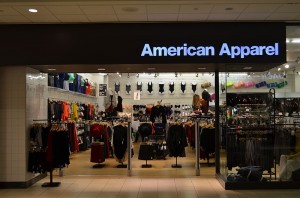is american apparel’s latest campaign exploiting garment workers?
US clothing brand, American Apparel is no stranger to controversy, but the retailer’s latest campaign featuring a Bangladesh-born model with the words ‘Made in Bangladesh‘ sprawled across her bare chest has raised a few eyebrows, and sparked a lot of misguided criticism. The marketing scandal portrays a culturally-conflicting image of an exotic, Bangladeshi-American woman in an unusual bid to promote cultural diversity and self expression.
The 22-year-old model, Maks, poses topless in the advertisement, and wears only a pair of American Apparel high-waisted jeans. It is extremely refreshing to see the high-end retailer embracing racial diversity and empowering women, however, many people have expressed an aversion to the way the advertisement apparently exploits the Bangladesh garment workers who tirelessly labour over the clothes the brand sells.
In no way does American Apparel mistreat or underpay its factory workers, but the controversial campaign has been criticised for using the term ‘Made in Bangladesh’ as an inference to the under-appreciated Bangladesh factories that produce the clothes. The slogan was perhaps coined in order to broadcast the brand’s ethnic diversity and to salute the global trade that supports clothing retailers, but has resulted in quite the opposite, with some online users labelling the campaign ‘racist’ and ‘distasteful’.
It is perhaps the fatal collapse of a Bangladesh clothing factory last year that makes the ad even more confronting. Through sexualising the former-Muslim model, the retailer has constructed a glamorous fantasy of what being ‘made in Bangladesh’ really means – a world away from the industrial factories that actually produce the garments.
The campaign Westernises the traditional Bengali woman, and has potentially offended the Muslim culture that encourages modesty in clothing and self-representation. American Apparel’s Creative Director Iris Alonzo has said the campaign’s aim was to ‘celebrate women, diversity, healthy body image and female empowerment.’ Yet, the almost-nude pose and striking view of the model’s chest will appeal only to the Western culture the advertisement is directed towards, and not the Bangladesh roots it supposedly celebrates.
But the question that remains is what do advertisements such as American Apparel’s say about how we commodify women? Especially women of colour. It’s hard to interpret whether the slogan refers to the jeans or the model being ‘Made in Bangladesh.’ Yes, the objectification of women in fashion advertisements is common, yet some people are possibly analysing American Apparel’s intentions too deeply.
The model, born in Dhaka, Bangladesh and raised in California, ‘unreservedly embraced this photo shoot’ as the text at the bottom of the advertisement explains. The advertisement is an avenue for Maks to unreservedly embrace her self-expression and creativity, stepping away from her conservative Islamic roots.
This controversy proves the modern proverb: sex sells. Retailers will continue to push the marketing of women and the female body because it either lures people in, or steps on enough important toes to make international news.
Ultimately, a beautiful woman forging her own identity and unabashedly warming to a different way of life is the narrative hidden within the advertisement that has unfortunately been overlooked.



Isn’t it funny how western people call this ‘racist’ as it ‘so far from her original roots’ and does not ‘appeal’ to Bangladeshi culture. It is in fact racist in itself to assume we must keep non-western women within their cultural boundaries, not allowing them to become figures that deflect the stereotypes of their previous cultures or religions. When globalization is so highly contagious within the world westerners cry that we must not tarnish the non-western people of the world with our ways. This is in fact oppressing their right to self discovery, self-expression and development and keeping them confined within the exotic ‘other’ stereotypes that stem from Said’s notion of Orientalism.
As much as this is a nod of the head to diversity, there is no diversity in the bodies displayed in American Apparel’s advertising. They are all a different version of the same model, the predominant feature being thinness, and the always-present angle being sexualisation.
Forget the Creative Director’s bullshit claim about promoting ‘healthy body image’ – AA normalises the body shape that we see everywhere in Western culture.
Whatever clever and edgy marketing AA produces, I will never be convinced that the company values women beyond their narrow definition of beauty.